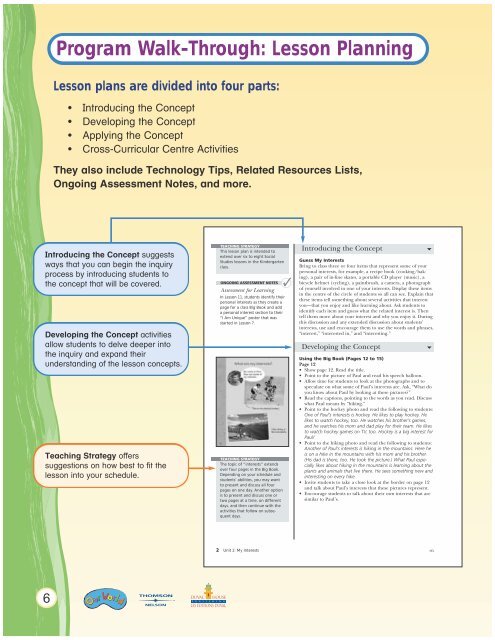Download the K TR Sampler - Nelson Education
Download the K TR Sampler - Nelson Education
Download the K TR Sampler - Nelson Education
You also want an ePaper? Increase the reach of your titles
YUMPU automatically turns print PDFs into web optimized ePapers that Google loves.
Program Walk-Through: Lesson Planning<br />
Lesson plans are divided into four parts:<br />
• Introducing <strong>the</strong> Concept<br />
• Developing <strong>the</strong> Concept<br />
• Applying <strong>the</strong> Concept<br />
• Cross-Curricular Centre Activities<br />
They also include Technology Tips, Related Resources Lists,<br />
Ongoing Assessment Notes, and more.<br />
Introducing <strong>the</strong> Concept suggests<br />
ways that you can begin <strong>the</strong> inquiry<br />
process by introducing students to<br />
<strong>the</strong> concept that will be covered.<br />
Developing <strong>the</strong> Concept activities<br />
allow students to delve deeper into<br />
<strong>the</strong> inquiry and expand <strong>the</strong>ir<br />
understanding of <strong>the</strong> lesson concepts.<br />
Teaching Strategy offers<br />
suggestions on how best to fit <strong>the</strong><br />
lesson into your schedule.<br />
TEACHING S<strong>TR</strong>ATEGY<br />
This lesson plan is intended to<br />
extend over six to eight Social<br />
Studies lessons in <strong>the</strong> Kindergarten<br />
class.<br />
ONGOING ASSESSMENT NOTES<br />
Assessment for Learning<br />
In Lesson 11, students identify <strong>the</strong>ir<br />
personal interests as <strong>the</strong>y create a<br />
page for a class Big Book and add<br />
a personal interest section to <strong>the</strong>ir<br />
“I Am Unique” poster that was<br />
started in Lesson 7.<br />
TEACHING S<strong>TR</strong>ATEGY<br />
The topic of “interests” extends<br />
over four pages in <strong>the</strong> Big Book.<br />
Depending on your schedule and<br />
students’ abilities, you may want<br />
to present and discuss all four<br />
pages on one day. Ano<strong>the</strong>r option<br />
is to present and discuss one or<br />
two pages at a time, on different<br />
days, and <strong>the</strong>n continue with <strong>the</strong><br />
activities that follow on subsequent<br />
days.<br />
✓<br />
Introducing <strong>the</strong> Concept<br />
Guess My Interests<br />
Bring to class three or four items that represent some of your<br />
personal interests, for example, a recipe book (cooking/baking),<br />
a pair of in-line skates, a portable CD player (music), a<br />
bicycle helmet (cycling), a paintbrush, a camera, a photograph<br />
of yourself involved in one of your interests. Display <strong>the</strong>se items<br />
in <strong>the</strong> centre of <strong>the</strong> circle of students so all can see. Explain that<br />
<strong>the</strong>se items tell something about several activities that interest<br />
you—that you enjoy and like learning about. Ask students to<br />
identify each item and guess what <strong>the</strong> related interest is. Then<br />
tell <strong>the</strong>m more about your interest and why you enjoy it. During<br />
this discussion and any extended discussion about students’<br />
interests, use and encourage <strong>the</strong>m to use <strong>the</strong> words and phrases,<br />
“interest,” “interested in,” and “interesting.”<br />
Developing <strong>the</strong> Concept<br />
Using <strong>the</strong> Big Book (Pages 12 to 15)<br />
Page 12<br />
• Show page 12. Read <strong>the</strong> title.<br />
• Point to <strong>the</strong> picture of Paul and read his speech balloon.<br />
• Allow time for students to look at <strong>the</strong> photographs and to<br />
speculate on what some of Paul’s interests are. Ask, “What do<br />
you know about Paul by looking at <strong>the</strong>se pictures?”<br />
• Read <strong>the</strong> captions, pointing to <strong>the</strong> words as you read. Discuss<br />
what Paul means by “hiking.”<br />
• Point to <strong>the</strong> hockey photo and read <strong>the</strong> following to students:<br />
One of Paul’s interests is hockey. He likes to play hockey. He<br />
likes to watch hockey, too. He watches his bro<strong>the</strong>r’s games,<br />
and he watches his mom and dad play for <strong>the</strong>ir team. He likes<br />
to watch hockey games on TV, too. Hockey is a big interest for<br />
Paul!<br />
• Point to <strong>the</strong> hiking photo and read <strong>the</strong> following to students:<br />
Ano<strong>the</strong>r of Paul’s interests is hiking in <strong>the</strong> mountains. Here he<br />
is on a hike in <strong>the</strong> mountains with his mom and his bro<strong>the</strong>r.<br />
(His dad is <strong>the</strong>re, too. He took <strong>the</strong> picture.) What Paul especially<br />
likes about hiking in <strong>the</strong> mountains is learning about <strong>the</strong><br />
plants and animals that live <strong>the</strong>re. He sees something new and<br />
interesting on every hike.<br />
• Invite students to take a close look at <strong>the</strong> border on page 12<br />
and talk about Paul’s interests that <strong>the</strong>se pictures represent.<br />
• Encourage students to talk about <strong>the</strong>ir own interests that are<br />
similar to Paul’s.<br />
2 Unit 2: My Interests NEL<br />
6

















